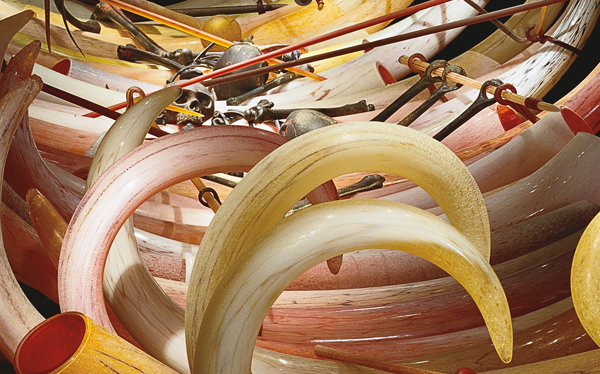William Morris Cache




WILLIAM MORRIS Cache
"By reminding us of the ancient past, we are confronted in Morris' work by contrast with our troubled present. By avoiding the scolding character of political art, he proposes relief, an escape into the past that is really a window onto the present, a present that sidesteps systems and elevates custom, ritual and a masculinity under assault."
Matthew Kangas
William Morris Artifacts / Glass
William Morris' masterpiece, Cache, is arguably the most important installation ever produced by this artist. Measuring thirty-six feet in length, Cache was first exhibited at the American Craft Museum (now the Museum of Arts and Design) in New York City, Morris' first major single artist exhibition.
The enigmatic Cache is formed from a bed of enormous blown "tusks," evocative of an elephant burial ground—or a stockpile of confiscated contraband. Within the installation are human skulls and bone fragments, animal horns, arrows, gourds, and countless variations on the shape of a traditional African tribal scepter called an orinka. Cache represents the culmination of Morris' Artifact Series, in which he produced innumerable single objects and installations referring to prehistoric past cultures and civilizations.
Morris was a staff member at Pilchuck Glass School in the mid 1970s when he met Dale Chihuly. Morris became Chihuly's protégé and, ultimately, his head gaffer and chief glassblower. But by the early 1980s, Morris had developed his own studio practice, focusing on imagery from prehistory in a somber, earth-toned palette. Cache epitomizes Morris' emergence as an international figure in the Studio Glass movement.
Number of works in the exhibition:
Cache is one installation, measuring 5 x 6 x 36 feet.
Space requirement:
At least 60 linear feet within a gallery that would accommodate visitors to safely move around the installation; approximately 1200 square feet